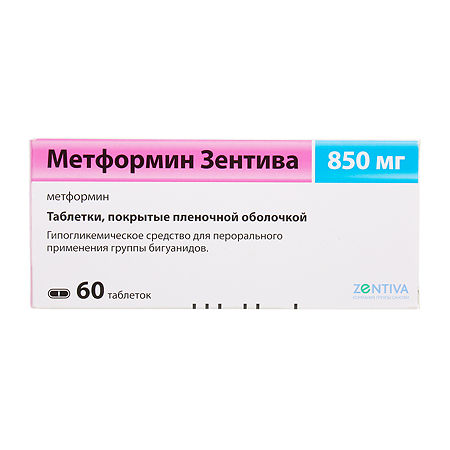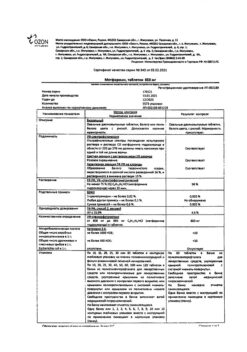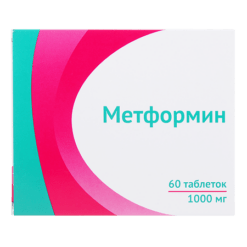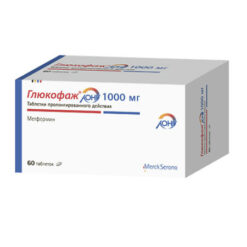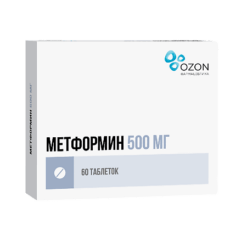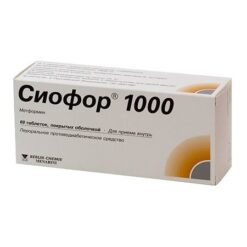No products in the cart.
Sanofi Metformin, 850 mg 60 pcs
€1.00
Out of stock
(E-mail when Stock is available)
Description
Hypoglycemic drug for oral administration. Metformin is a biguanide with hypoglycemic effect, which determines the decrease of basal (on an empty stomach) and postprandial (2 hours after the beginning of the meal) plasma glucose concentration. Unlike sulfonylurea derivatives, metformin does not stimulate insulin secretion by pancreatic beta-cells and does not create a risk of hypoglycemia.
It increases the sensitivity of peripheral receptors to insulin and glucose utilization by cells. Reduces glucose production by the liver by inhibiting gluconeogenesis and glycogenolysis. Delays absorption of glucose in the intestine.
Metformin stimulates the synthesis of intracellular glycogen by acting on glycogen synthase. It increases transport capacity of all types of membrane glucose transporters.
Metformin has a favorable effect on lipid metabolism: it reduces total cholesterol, LDL and triglycerides.
With metformin, a patient’s body weight either remains stable or decreases moderately.
Pediatric population
In patients aged 10-16 years who were treated with metformin for 1 year, glycemic control rates were comparable to those in the adult population.
Pharmacokinetics
Intake
After oral administration, metformin is absorbed in the GI tract. Cmax is reached 2.5 h after oral administration. Bioavailability for doses of 500 and 850 mg in healthy subjects is 50-60%. Absorption of metformin when ingested is saturable and incomplete. It is assumed that the pharmacokinetics of metformin absorption is non-linear. When metformin is used in the recommended doses and according to the recommended regimen, Css in plasma is reached within 24-48 hours and is usually less than 1 µg/ml. C max of metformin does not exceed 5 µg/ml, even when the drug is used at maximum doses.
Eating reduces the extent and slightly slows down the absorption of metformin. After oral administration of 850 mg tablet, there is a 40% decrease in C max, a 25% decrease in AUC and a 35 min increase in time to reach C max.
Distribution
Metformin is rapidly distributed in the tissues, with little or no binding to plasma proteins. Metformin penetrates the erythrocytes. C max in blood is lower than C max in plasma and is reached at about the same time. Erythrocytes likely represent a secondary depot of distribution. The average Vd is between 63 and 276 L.
Metabolism
Metformin is excreted unchanged by the kidneys, undergoes very little metabolism, no metabolites have been identified.
Elimination
After oral administration of the drug, 20-30% of the unabsorbed substance is excreted through the intestine. Renal clearance of metformin is more than 400 ml/min, indicating excretion of metformin by active glomerular filtration and tubular secretion. After oral administration, the T1/2 is about 6.5 h.
In impaired renal function, cumulation of the drug is possible, which leads to increased plasma concentrations of metformin.
Patient special groups
Patients with impaired renal function. The data available in patients with moderate renal impairment are sparse and do not allow a reliable assessment of the systemic effects of metformin in this subgroup, as can be done in those with normal renal function.
Patients in pediatric patients. After a single administration of metformin at a dose of 500 mg, pediatric patients showed a pharmacokinetic profile similar to that observed in healthy adults. After a repeated use of metformin in dose of 500 mg 2 times per day for 7 days in children Cmax and AUC0-t were decreased by approximately 33% and 40%, respectively, compared to the values of these parameters in adult patients with diabetes who received metformin in dosage of 500 mg 2 times per day for 14 days. Because the dose of the drug is adjusted individually according to glycemic levels, these data are of limited clinical significance.
Indications
Indications
Diabetes mellitus type 2 (especially in obese patients) with ineffective diet therapy and physical activity:
in adults as monotherapy or in combination with other oral hypoglycemic agents or insulin;
in children over 10 years of age as monotherapy and in combination with insulin.
Pharmacological effect
Pharmacological effect
Hypoglycemic drug for oral use. Metformin is a biguanide with a hypoglycemic effect, which determines a decrease in basal (fasting) and postprandial (2 hours after the start of a meal) plasma glucose concentrations. Unlike sulfonylurea derivatives, metformin does not stimulate insulin secretion by pancreatic beta cells and does not pose a risk of hypoglycemia.
Increases the sensitivity of peripheral receptors to insulin and the utilization of glucose by cells. Reduces liver glucose production by inhibiting gluconeogenesis and glycogenolysis. Delays the absorption of glucose in the intestines.
Metformin stimulates the synthesis of intracellular glycogen by acting on glycogen synthase. Increases the transport capacity of all types of membrane glucose transporters.
Metformin has a beneficial effect on lipid metabolism: it reduces the content of total cholesterol, LDL and triglycerides.
While taking metformin, the patient’s body weight either remains stable or decreases moderately.
Pediatric population
In patients aged 10-16 years who were treated with metformin for 1 year, glycemic control rates were comparable to those in the adult population.
Pharmacokinetics
Suction
After oral administration, metformin is absorbed into the gastrointestinal tract. Cmax is reached 2.5 hours after oral administration. Bioavailability for dosages of 500 and 850 mg in healthy people is 50-60%. Absorption of metformin when taken orally is saturable and incomplete. It is assumed that the pharmacokinetics of metformin absorption is nonlinear. When metformin is used in recommended doses and according to the recommended regimen, Css in blood plasma is achieved within 24-48 hours and is usually less than 1 mcg/ml. Cmax of metformin does not exceed 5 mcg/ml, even when using the drug in maximum doses.
Eating reduces the degree and somewhat slows down the absorption of metformin. After oral administration of an 850 mg tablet, a decrease in Cmax by 40%, a decrease in AUC by 25% and an increase in the time to reach Cmax by 35 minutes are observed.
Distribution
Metformin is quickly distributed in tissues and practically does not bind to blood plasma proteins. Metformin penetrates into red blood cells. Cmax in the blood is lower than Cmax in the blood plasma and is achieved approximately simultaneously. Red blood cells most likely represent a secondary distribution depot. Average Vd is in the range of 63-276 liters.
Metabolism
Metformin is excreted unchanged by the kidneys and undergoes very little metabolism; no metabolites have been identified.
Removal
After taking the drug orally, 20-30% of the unabsorbed substance is excreted through the intestines. The renal clearance of metformin is more than 400 ml/min, indicating that metformin is eliminated by active glomerular filtration and tubular secretion. After oral administration, T1/2 is about 6.5 hours.
If renal function is impaired, drug accumulation is possible, which leads to an increase in the concentration of metformin in the blood plasma.
Special patient groups
Patients with impaired renal function. Available data from patients with moderate renal impairment are limited and do not allow the systemic exposure of metformin to be reliably assessed in this subgroup as can be done in individuals with normal renal function.
Pediatric patients. After a single dose of metformin 500 mg in pediatric patients, a pharmacokinetic profile similar to that observed in healthy adults was revealed. After repeated use of metformin at a dose of 500 mg 2 times a day for 7 days in children, Cmax and AUC0-t were reduced by approximately 33% and 40%, respectively, compared with the values of these parameters in adult patients with diabetes mellitus receiving metformin at a dosage of 500 mg 2 times a day for 14 days. Since the dose of the drug is selected individually depending on the level of glycemia, these data have limited clinical significance.
Special instructions
Special instructions
Lactic acidosis
Lactic acidosis is a rare, but serious (high mortality if not treated immediately), metabolic complication that may occur due to accumulation of metformin. There are reports of cases of lactic acidosis during metformin therapy in patients with diabetes mellitus and with severe renal failure or acute deterioration of renal function. Particular attention should be paid to situations where renal dysfunction may occur, for example in the case of dehydration (with severe diarrhea or vomiting) or when starting antihypertensive therapy or therapy with diuretics (especially loop diuretics), as well as when starting NSAID therapy. If these acute conditions occur, therapy with Metformin Zentiva should be temporarily discontinued.
Other associated risk factors should also be taken into account, such as decompensated diabetes mellitus, ketosis, prolonged fasting, excessive alcohol consumption, liver failure and any condition associated with severe hypoxia (for example, heart failure with unstable hemodynamic parameters, respiratory failure, acute myocardial infarction).
The risk of developing lactic acidosis should be taken into account when nonspecific signs appear, such as muscle cramps, dyspeptic disorders, abdominal pain and severe asthenia. Patients should be instructed to promptly report the occurrence of these symptoms to their physician, especially if the patient has previously tolerated metformin therapy. In this case, therapy with Metformin Zentiva should be discontinued, at least temporarily, until the situation is clarified. The question of resuming therapy must be decided individually, taking into account the benefit/risk ratio, as well as taking into account the state of renal function in a given patient.
Diagnosis: lactic acidosis is characterized by acidotic shortness of breath, abdominal pain, hypothermia followed by coma. Laboratory findings include: decreased blood pH (less than 7.25), plasma lactic acid concentration greater than 5 mmol/L, and increased anion gap and lactate/pyruvate ratio. If metabolic acidosis is suspected, metformin should be stopped and the patient should be hospitalized immediately.
Doctors should inform patients about the risk of developing lactic acidosis and its symptoms.
Surgical operations
You should stop taking Metformin Zentiva 48 hours before planned surgery under anesthesia, spinal or epidural anesthesia. Therapy can be resumed no earlier than 48 hours after surgery or after restoration of food intake and only if renal function is normal.
Kidney function
Because Metformin is excreted by the kidneys, creatinine clearance should be monitored before starting therapy and then regularly:
at least once a year in patients with normal renal function;
at least 2-4 times a year in patients with a CC value at the lower limit of normal and in elderly patients.
When CC <45 ml/min (GFR <45 ml/min/1.73 m2 body surface), the use of Metformin Zentiva is contraindicated.
Deterioration of kidney function in elderly patients is often asymptomatic.
Particular caution should be exercised in case of possible impairment of renal function in case of dehydration or with simultaneous use of antihypertensive drugs, diuretics (especially loop diuretics) or NSAIDs. In these cases, it is also recommended to check the status of kidney function before starting therapy with Metformin Zentiva.
Heart failure
Patients with heart failure have a higher risk of developing hypoxia and renal failure. In patients with stable chronic heart failure, Metformin Zentiva can be used subject to regular monitoring of cardiac function and renal function.
The use of Metformin Zentiva is contraindicated in patients with acute or chronic heart failure with unstable hemodynamic parameters.
Reproductive function
Metformin had no effect on reproductive function in male or female rats at doses up to 600 mg/kg/day, which is approximately 3 times the maximum recommended daily dose in humans based on body surface area comparisons.
Children and teenagers
The diagnosis of type 2 diabetes mellitus must be confirmed before initiating therapy with Metformin Zentiva.
In controlled clinical studies lasting one year, there was no effect of metformin on the growth and puberty of children. However, due to the lack of long-term data, close monitoring of the subsequent effect of metformin on these parameters is recommended in children taking Metformin Zentiva, especially in children aged 10-12 years.
Other Precautions
Patients should follow a diet with regular carbohydrate intake throughout the day. Overweight patients should continue to follow a low-calorie diet (but not less than 1000 kcal per day).
Standard laboratory tests should be performed regularly to monitor diabetes mellitus.
Metformin alone does not cause hypoglycemia; however, caution is recommended when using it in combination with insulin or other hypoglycemic agents (for example, sulfonylureas, repaglinide).
Long-term therapy with metformin is accompanied by a decrease in the concentration of vitamin B12 in the blood plasma, which can cause peripheral neuropathy. Regular monitoring of vitamin B12 concentrations in blood plasma is recommended.
Impact on the ability to drive vehicles and operate machinery
The use of Metformin Zentiva as monotherapy does not affect the ability to drive vehicles and operate machinery.
When combining the drug Metformin Zentiva with other hypoglycemic agents (including sulfonylurea derivatives, insulin, meglitinides), it is necessary to warn patients about the possibility of developing hypoglycemic conditions, which impair the ability to drive vehicles and engage in other potentially hazardous activities that require increased attention and rapid psychomotor reactions.
Composition
Composition
1 tablet contains:
Active substances:
metformin 850 mg.
Excipients:
starch 1500 (partially pregelatinized),
povidone,
croscarmellose sodium,
magnesium stearate,
microcrystalline cellulose,
Opadry II shell composition:
polyvinyl alcohol (partially hydrolyzed), macrogol 3350 (polyethylene glycol), coloring pigment (titanium dioxide (E 171), aluminum varnish based on indigo carmine (E 132), aluminum varnish based on quinoline yellow (E 104))
Contraindications
Contraindications
Hypersensitivity to metformin or any excipient included in the drug;
diabetic ketoacidosis, diabetic precoma, coma;
moderate to severe renal failure or impaired renal function (CK<45 ml/min, GFR<45 ml/min/1.73 m2 body surface area);
acute conditions that occur with a risk of developing renal dysfunction: dehydration (with diarrhea, vomiting), fever, severe infectious diseases, shock;
acute and chronic diseases that can lead to the development of tissue hypoxia (such as acute myocardial infarction, shock, heart failure with unstable hemodynamic parameters, respiratory failure);
lactic acidosis (including history);
extensive surgical operations and injuries (against which insulin therapy is indicated);
liver dysfunction;
chronic alcoholism, acute alcohol intoxication;
use within less than 48 hours before and within 48 hours after radioisotope or x-ray studies with intravenous administration of an iodine-containing x-ray contrast agent;
following a hypocaloric diet (less than 1000 kcal/day);
pregnancy.
The drug should be used with caution in patients over 60 years of age who perform heavy physical work, which is associated with an increased risk of developing lactic acidosis; in patients with impaired renal function (creatinine clearance 45-59 mmol/l, eGFR 45-59 ml/min/1.73 m2 body surface); during breastfeeding.
Side Effects
Side Effects
When using metformin, the following side effects may occur, which are divided into system-organ classes in accordance with the MedDRA classification. Determination of the frequency of side effects, according to the WHO classification: very often (≥10%); often (≥1% and <10%); uncommon (≥0.1% and <1%); rare (≥0.01% and <0.1%); very rare (<0.01%); frequency is unknown (it is not possible to determine the frequency of occurrence of a side effect based on available data).
From the blood and lymphatic system: frequency unknown – hemolytic anemia.
Metabolism and nutrition: very rarely – lactic acidosis, decreased absorption of vitamin B12 in patients with megaloblastic anemia; frequency unknown – peripheral neuropathy in patients with vitamin B12 deficiency.
From the nervous system: often – distortion of taste sensations; frequency unknown – encephalopathy.
From the gastrointestinal tract: very often – nausea, vomiting, diarrhea, abdominal pain, loss of appetite. These undesirable effects most often occur during the initiation of therapy and in most cases resolve on their own. To prevent their occurrence, it is recommended to take the daily dose of metformin in 2 or 3 doses during or after meals. Slowly increasing the dose of the drug may improve gastrointestinal tolerability.
From the skin and subcutaneous tissues: very rarely – erythema, itching, urticaria; frequency unknown – photosensitivity.
From the liver and biliary tract: very rarely – increased activity of liver transaminases or hepatitis, which disappear after discontinuation of the drug.
Impact on the results of laboratory and instrumental studies: frequency unknown – decrease in plasma TSH concentration in patients with hypothyroidism, hypomagnesemia due to diarrhea.
Children and teenagers
Published data, post-marketing data, and controlled clinical trials in a limited population of children aged 10-16 years treated with metformin for 1 year indicate that adverse events in children are similar in nature and severity to those in adult patients.
Interaction
Interaction
Contraindicated combinations
Iodine-containing radiocontrast agents
Intravascular administration of iodinated radiocontrast agents can lead to the development of functional renal failure, thereby increasing the accumulation of metformin and the risk of lactic acidosis. In patients with GFR >60 ml/min/1.73 m2 body surface area, metformin should be discontinued before or during the X-ray examination and not restarted for 48 hours after the examination, provided that normal renal function is confirmed. In patients with moderate renal impairment (GFR 45-60 ml/min/1.73 m2), metformin should be discontinued 48 hours before administration of an iodinated contrast agent and resumed no earlier than 48 hours after completion of the study and only after re-evaluation of renal function if there are no signs of deterioration.
Combinations not recommended
Alcohol
Acute alcohol intoxication increases the risk of developing lactic acidosis, especially in cases of fasting or malnutrition, following a low-calorie diet, or liver failure. While taking the drug, you should avoid drinking alcohol and medications containing ethanol.
Combinations requiring caution
Danazol
Concomitant use of danazol is not recommended to avoid the hyperglycemic effect of the latter. If treatment with danazol is necessary and after discontinuation of the latter, a dose adjustment of metformin is required under the control of blood glucose concentrations.
Chlorpromazine
Chlorpromazine, when taken in high doses (100 mg/day), increases the concentration of glucose in the blood, reducing the release of insulin. During treatment with antipsychotics and after stopping their use, dose adjustment of metformin is required under the control of blood glucose concentrations.
GKS
GCS of systemic and local action reduce glucose tolerance, increase the concentration of glucose in the blood, sometimes causing ketosis. When treating corticosteroids and after stopping their use, dose adjustment of metformin is required under the control of blood glucose concentrations.
Diuretics (especially loop diuretics)
Concomitant use of loop diuretics may lead to the development of lactic acidosis due to possible functional renal failure. Metformin should not be prescribed to patients if CC is below 60 ml/min.
Beta2-agonists in the form of injections
Beta2-adrenergic agonists increase blood glucose concentrations due to stimulation of beta2-adrenergic receptors. In this case, it is advisable to regularly monitor the concentration of glucose in the blood. If necessary, insulin administration is recommended.
When using the above drugs simultaneously, the dose of metformin can be adjusted during treatment or after its cessation.
Antihypertensive drugs, with the exception of ACE inhibitors, can change the concentration of glucose in the blood. If necessary, the dose of metformin should be adjusted.
Sulfonylureas, insulin and acarbose
When used simultaneously with metformin, hypoglycemia may develop.
Salicylates
When used simultaneously with metformin, hypoglycemia may develop.
Nifedipine
Increases absorption and increases Cmax of metformin.
Cationic drugs
Amiloride, digoxin, morphine, procainamide, quinidine, quinine, ranitidine, triamterene, trimethoprim and vancomycin, excreted by the renal tubules, compete with metformin for tubular transport systems and can lead to an increase in Cmax up to 60%.
The hypoglycemic effect of metformin can be reduced by phenothiazines, glucagon, estrogens, including those contained in oral contraceptives, phenytoin, sympathomimetics, nicotinic acid, isoniazid, and slow calcium channel blockers.
Levothyroxine may reduce the hypoglycemic effect of metformin. Monitoring blood glucose concentrations is recommended, particularly when initiating or stopping thyroid hormone therapy, and the dose of metformin should be adjusted if necessary.
With simultaneous use of metformin with NSAIDs, MAO inhibitors, oxytetracycline, fibric acid derivatives, cyclophosphamide, probenecid, chloramphenicol, sulfonamide antimicrobials, the hypoglycemic effect of metformin may be enhanced.
Propranolol, ibuprofen
In healthy volunteers, in single-dose studies of metformin and propranolol, as well as metformin and ibuprofen, no changes in their pharmacokinetic parameters were observed.
Metformin may help reduce the therapeutic effect of the anticoagulant phenprocoumon. Close monitoring of MHO is recommended during coadministration.
Overdose
Overdose
Symptoms: when used at a dose of 85 g (42.5 times the maximum daily dose), no hypoglycemia was observed. In case of an overdose of metformin, lactic acidosis may develop. Lactic acidosis is an emergency and requires hospital treatment. The cause of the development of lactic acidosis may also be the accumulation of the drug due to impaired renal function.
Early symptoms of lactic acidosis are nausea, vomiting, diarrhea, low body temperature, abdominal pain, muscle pain, and later rapid breathing, dizziness, impaired consciousness and the development of coma may occur.
An overdose of metformin may cause pancreatitis.
Treatment: if signs of lactic acidosis appear, treatment with metformin should be stopped immediately, the patient should be urgently hospitalized, the concentration of lactic acid in the blood plasma should be determined and the diagnosis confirmed. The most effective procedure for removing lactic acid and metformin from the body is hemodialysis. Symptomatic treatment is also carried out.
Manufacturer
Manufacturer
Sanofi India Ltd, India
Additional information
| Manufacturer | Sanofi India Limited, India |
|---|---|
| Medication form | pills |
| Brand | Sanofi India Limited |
Other forms…
Related products
Buy Sanofi Metformin, 850 mg 60 pcs with delivery to USA, UK, Europe and over 120 other countries.

